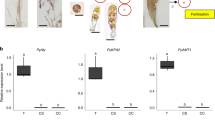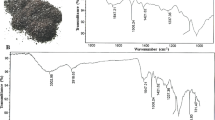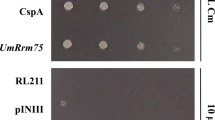Abstract
SEVERAL investigators, including Janczewski1, Thuret and Bornet2, Berthold3 and more recently Okamura, Onda and Higashi4, have successfully germinated the carpospores of various species of Porphyra and obtained thereby filamentous growths. However, it has never been clearly demonstrated step by step how the leafy thallus originated again, although some workers have succeeded in inducing further growth than others and made observations on which various theories have been based. Grubb5 describes the liberation of the contents of the terminal cell of a short swollen filament as well as empty swollen tips of others. Both Kylin6 and Rees7,8 considered they saw evidence of the formation of monospores on the filaments, and it has been assumed that these germinated into the leafy thallus, although the possibility of such spores reproducing the filamentous stage cannot be ruled out. In Dangeard's9 view, the filamentous growth is protonemal, the leafy thallus developing on it as ‘buds'—a view contested by Rees7. At the other extreme, these filamentous growths from the carpospores have been considered pathological by Kunieda10, who asserts that the carpospores of the Japanese species, P. tenera Kjellmann, produced in the spring spend the summer in a resting condition. In the autumn, he considers they germinate direct into the leafy thallus, as do the monospores of all species which have been investigated. An earlier Japanese worker, Yendo11, described the liberation of ciliated micro- and macrogametes from the original spore as well as other swollen cells of the filamentous growths ; but it seems possible such spores belonged to an endophytic fungus.
This is a preview of subscription content, access via your institution
Access options
Subscribe to this journal
Receive 51 print issues and online access
$199.00 per year
only $3.90 per issue
Buy this article
- Purchase on Springer Link
- Instant access to full article PDF
Prices may be subject to local taxes which are calculated during checkout
Similar content being viewed by others
References
Janczewski, E., Ann. Sci. Nat., Bot. sér., 5, 17 (1873).
Thuret, G., and Bornet, E., “Études phycologiques’ (Paris, 1878).
Berthold, G., “Fauna u. Flora d. Golfes v. Neapel, etc.", 8 (1882).
Okamura, K., Onda, K., and Higashi, M., Bot. Mag. (Tokyo), 34 (1920).
Grubb, V. M., Rev. Algol., 1 (1924).
Kylin, H., Arkiv. Bot., 17, No. 5 (1922).
Rees, T. K., J. Ecol., 28 (1940).
Rees, T. K., Ann. Bot., N.S., 4 (1940).
Dangeard, P., “Traité d'Algologie’ (Paris, 1933).
Kunieda, H., J. Coll. Agric., Tokyo, 14 (1939).
Yendo, K., Bot. Mag. (Tokyo), 33 (1919).
Batters, E. A. L., Phycol. Mem., 1 (1892).
Dangeard, P., Botaniste, 18 (1927).
Author information
Authors and Affiliations
Rights and permissions
About this article
Cite this article
DREW, K. Conchocelis-Phase in the Life-History of Porphyra umbilicalis (L.) Kütz. Nature 164, 748–749 (1949). https://doi.org/10.1038/164748a0
Issue Date:
DOI: https://doi.org/10.1038/164748a0
This article is cited by
-
Concise review of the genus Neopyropia (Rhodophyta: Bangiales)
Journal of Applied Phycology (2022)
-
Development of Chromatin Immunoprecipitation for the Analysis of Histone Modifications in Red Macroalga Neopyropia yezoensis (Rhodophyta)
Molecular Biotechnology (2022)
-
The occurrence of Phycocalidia tanegashimensis (Bangiaceae) in the splash zone may be related to the tolerance of photochemical efficiency to temperature, irradiance, desiccation, and salinity
Journal of Applied Phycology (2021)
-
Temperature characteristics on the growth and photosynthesis of a red alga Phycocalidia tanegashimensis (= Pyropia tanegashimensis, Bangiales) reveal adaptation to subtropical environments due to year-round occurrence of the macroscopic gametophyte
Journal of Applied Phycology (2021)
-
Chronic effects of three different stressors, irradiance, temperature, and desiccation, on the PSII photochemical efficiency in the heteromorphic life-history stages of cultivated Pyropia yezoensis f. narawaensis (Bangiales) from Japan
Journal of Applied Phycology (2020)
Comments
By submitting a comment you agree to abide by our Terms and Community Guidelines. If you find something abusive or that does not comply with our terms or guidelines please flag it as inappropriate.



